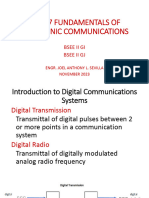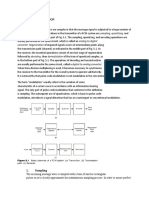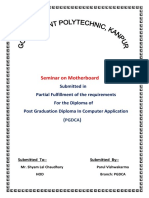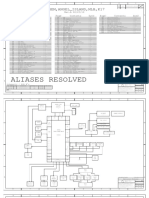ELEC 382 Notes 13 Wired Digital Communication
ELEC 382 Notes 13 Wired Digital Communication
Uploaded by
Kenan BaltaciCopyright:
Available Formats
ELEC 382 Notes 13 Wired Digital Communication
ELEC 382 Notes 13 Wired Digital Communication
Uploaded by
Kenan BaltaciCopyright
Available Formats
Share this document
Did you find this document useful?
Is this content inappropriate?
Copyright:
Available Formats
ELEC 382 Notes 13 Wired Digital Communication
ELEC 382 Notes 13 Wired Digital Communication
Uploaded by
Kenan BaltaciCopyright:
Available Formats
ELEC 382 ELECTRONIC COMMUNICATIONS Chapter 9: Wired Digital Communications Communication Links and Protocols Some of the earliest
forms of electrical communications like telegraph used coding to send messages rather than direct transmission of voice. Again with advances in technology, digital communication is the promise to help ease the problems of overcrowded voice transmission facilities. The future will certainly bring more and more coded speech, transmitted in digital format because of the following advantages: 1. 2. 3. 4. 5. Less sensitive to noise, Less crosstalk (cochannel interference), Lower distortion levels, Faded signals more easily regenerated, Greater transmission efficiency
Coding is transforming messages or signals in accordance with a definite set of rules. There are many different codes available for use and most of the coding systems use two levels like a binary system. Communication Protocols (applied to both analog and digital systems): 1. Simplex: Communication is in one direction only. 2. Half Duplex: Communication is in both directions but only one can talk at a time. 3. Full-duplex: Both parties can talk at the same time. Synchronous Communication: The transmit and receive data clocks are locked together. Asynchronous Communication: The transmit and receive data clocks are not locked together. Protocol Functions: To maintain order during the interchange of data, rules to control the process are necessary. Initially, procedures, allowing orderly interchange between a central computer and remote sites were needed. These rules and procedures were called handshaking. As the complexity of data communication system is increased, the need grew for more. A protocol is a set of rules designed to force the devices sharing a channel to observe orderly communication procedures. Protocols have four major functions: 1. Framing: Data are normally transmitted in blocks. The framing function deals with the separation of blocks into the information (text) and the control sections. A maximum block size is dictated by the protocol. Each block will normally contain information such as an address field to indicate the intended recipient(s) of the data and block check character (BCC) for error detection. 2. Line Control is the procedure to decide which device has permission to transmit at any given time. In a simple full duplex system, with just two devices, line control is not necessary. However, systems with three or more devices, line control is obviously not necessary. However, systems with three or more devices (multipoint circuits) require line control. 3. Flow Control: Often, there is a limit to the rate at which a receiving device can accept data. Flow control is the protocol to monitor and control these rates
4. Sequence Control keeps message blocks from being lost or duplicated and ensures that they are received in the proper sequence. This is necessary for complex systems where a message must pass through numerous links before it reaches its final destination.
Example, Bit-oriented protocols (BOPs) use frame made up of well-defined fields between 8-bit start and stop flags. A flag is fixed in both length and pattern.
Figure 9-3 Bit-oriented protocol format, SDLC frame format 9.6. Delta and Pulse Modulation: Delta Modulation, sometimes called slope modulation is a digital coding system. It transmits information to indicate whether the analog signal it encodes is to go up or go down as shown in Figure 9-11. The system will work very well for slowly varying signals such as voice signals.
Figure 9-11 Linear delta modulation A delta modulator schematic is shown in Figure 9-12 A. A demodulator would consist of an integrator (just like the one in Figure 9-12) followed by a sharp-cutoff low-pas filter. The integrator output would look like the wavef orm in B. The filter smooths it out to provide the final analog signal. The major advantage of delta modulation is its simplicity. A difficulty faced by these systems is slope overload. When the analog signal has a high rate of change, the delta modulator can fall behind and a distorted output results.
Figure 9-12 Delta Modulator
Figure 9-13 Demodulation circuit for delta modulator Pulse Modulation Methods: There are four basic forms of pulse modulation: 1. Pulse-amplitude modulation (PAM) The PAM signal is a series of constant-width pulses whose amplitudes vary in accordance with the analog signal.
2. Pulse-width modulation (PWM) The PWM signal is binary in amplitude (has only two levels). The information signal varies the width or time duration of the pulse. 3. Pulse-position modulation (PPM) In PPM, the pulses change position according to the amplitude of the analog signal. 4. Pulse-code modulation (PCM). .. Of the four types of pulse modulation, PAM is the simplest and least expensive to implement. In all three cases, the analog signal is sampled, as it would be in A/D conversion.
Fig 9-14 Types of Pulse Modulation The most widely used technique for digitizing information signals for electronic data transmission is pulse-code modulation (PCM). PCM signals are serial digital data. There are two ways to generate: 1. Use an S/H circuit and traditional A/D converter to sample and convert the analog signal into a sequence of binary words, convert the parallel binary words into serial form, and transmit the data serially. 2. Use a delta modulator.
In traditional PCM, the analog signal is sampled and converted into a sequence of parallel binary words by an A/D converter. The parallel binary output word is converted into a serial signal by a shift register. Each time a sample is taken, an 8-bit word is generated by the A/D converter. This word must be transmitted serially before another sample is taken and another word is generated. The clock and start conversion signals are synchronized so that the resulting output signal is a continuous train of binary words. Data Transmission via AM The most elementary form of transmitting highs and lows is simply to key a transmitters carrier on and off. The carrier is conveying the intelligence by simply turning it on or off according to a prearranged code. This type of transmission is called continuous wave (CW) or interrupted continuous wave (ICW)
Figure 9-22 CW waveform The steep sides of the waveform are rich in harmonic content. This requires the channel bandwidth for transmission to be extremely wide or else adjacent channel interference would occur. The situation is remedied by use of an LC filter as shown in Figure 9-23. The filter is known as a keying filter and is also effective in blocking the radio frequency interference (RFI), generated by the arcing of the key contacts, from being transmitted.
Figure 9-23 Keying Filter and resulting waveform
Figure 9-24 Two tone Modulation System (AM) Two-Tone Modulation: Two-tone modulation is a form of AM, but in it the carrier is always transmitted. Instead of simply turning the carrier on and off, the carrier is amplitude-modulated by two different frequencies representing either a one or zero. The telegraphy system on Figure 9-24 is an example. When the carrier is keyed, the carrier is modulated by 470-Hz signal (1 condition); it is modulated by a 300-Hz signal for the 0 condition. At the receiver, after detection either 300- or 470-Hz signals are present. A 470-Hz bandpass filter provides an output for the 1 condition that makes the output high whenever 470 Hz is present and low otherwise.
Example 9-6: The two-tone modulation system in Figure 9-24 operates with a 10-MHz carrier. Determine all possible transmitted frequencies and the required bandwidth for this system.
ELEC 382 Electronic Communications Lab 13: Pulse Width Modulation
The input voltage in the circuit is adjusted with the pot and measured with the multimeter. Output of the comparator in the circuit is a periodic pulse whose width depends on the input voltage amplitude. Experimental Work: 1- Open the file PulseWMod file in MULTISIM. Adjust the input voltage to zero volts. Turn on the circuit and verify that the voltage is zero volts. If the voltage is not zero volts adjust it to zero volts using the pot. 2- Measure the pulse width and write it to the line with zero volt input voltage on the table below. Input voltage (volts) Pulse width at the output
0.0
3- Change the input values to three values between 0 volts and -5 volts using the pot. Write the input voltage and the output pulse width values to the table above. 4- Repeat step 3 for three voltages between 0 volts and +5 volts. 5- Sketch variation of the output pulse width with the input voltage on a graph.
6- As the input voltage increases the pulse width becomes smaller. What can you change in the circuit so that the pulse width becomes larger as you increase the input voltage?
7- Remove the multimeter, +12-source and -12-volt source. Connect the negative input of the comparator to an AC voltage source with 12-volt amplitude and 30 Hz frequency. Observe the input and the output voltages on the scope screen. Comment on the results.
8- Can you convert the output to an optical (light) signal? How?
9- How can the light signal you generated be received and converted to a sinusoidal circuit again?
Good luck Dr. Ahmet Turkmen
ELEC 382 Homework 6: Choose the one alternative that best completes the statement or answers the question. 1) A two-tone amplitude modulation system uses 400 Hz for a "one" and 550 Hz for a "zero" and a carrier frequency of 9.35 MHz. The required bandwidth for this communication channel is: A) 950 Hz B) 400 Hz. C) 1100 Hz D) 550 Hz E) 800 Hz 2) A certain language has 18 letters in its alphabet. How many bits are required to represent the 18 letters? A) 5 B) 4 C) 6 D) 3 3) Another name for delta modulation is ______________________. A) slope modulation B) codec C) pulse modulation D) all of the above 4) Which is not an advantage of digital data communication systems over analog communications? A) They eliminate errors in the received signal B) They have narrower bandwidths C) They have superior noise performance D) They have the ability to process the signal at the transmitter and receiver using digital signal processing techniques 5) Which of the following is not a major protocol function? A) flow control B) character insertion C) framing
D) line control
6) In ______________ protocol data flow is in one direction only. A) Half duplex B)Full duplex C) handshaking D) simplex 7) The other name of delta modulation is ________________________ A) PPM B) PWM C) Slope Modulation D) Linear Modulation 8) The high frequency components in interrupted continuous wave can be eliminated with a sharp A) knife B) saw D) filter D) demodulator 9) ____________________ protocol keeps message blocks from being lost or duplicated and ensures that they are received in the proper sequence. A) Flow Control B) Sequence Control D) Framing D) line Control 10) Position of a pulse changes according to the amplitude of the analog signal in ______________ system. A) PWMB) PAM C) PCM D) PPM 11) __________________ signal is a series of constant-width pulses whose amplitudes vary in accordance with the analog signal. A) PWMB) PAM C) PCM D) PPM 12) ______________ system generates a binary signal (with only two levels). The information signal varies the width or time duration of the pulse. A) PWM B) PAM C) PCM D) PPM 13) In a _______________ system, the input voltage value appears as a series port binary signal. A) PWMB) PAM C) PCM D) PPM
Good luck Dr. Ahmet Turkmen
You might also like
- CND PDFDocument1 pageCND PDFShiv100% (1)
- Orbcomm Ip Gateway Apivcd2Document52 pagesOrbcomm Ip Gateway Apivcd2Magdalena TerrasaNo ratings yet
- UNIT 5 Digital CommunicationDocument14 pagesUNIT 5 Digital CommunicationSunithaNo ratings yet
- Midterm Review (Chapter 1 and 2)Document8 pagesMidterm Review (Chapter 1 and 2)Kai BowenNo ratings yet
- Standard - Notes - TSN Unit III 2Document19 pagesStandard - Notes - TSN Unit III 2Priyabrata GhoraiNo ratings yet
- PCM TutorialDocument9 pagesPCM TutorialBen Babu PallikkunnelNo ratings yet
- 3G InterviewDocument21 pages3G InterviewPrashant KumarNo ratings yet
- Digital Communication (EC51)Document75 pagesDigital Communication (EC51)Manikandan PalaniNo ratings yet
- Analysis of Iterative Decoding For Turbo Codes Using Maximum A Posteriori AlgorithmDocument100 pagesAnalysis of Iterative Decoding For Turbo Codes Using Maximum A Posteriori AlgorithmWilliam Paul MacherlaNo ratings yet
- Ilovepdf Merged 2Document150 pagesIlovepdf Merged 2lavadiajhonNo ratings yet
- Preboard EST 2ndbatch April2015 SetBDocument15 pagesPreboard EST 2ndbatch April2015 SetBGeorge Ezar N. Quiriado100% (1)
- Digital CommunicationsDocument86 pagesDigital CommunicationspravalikaNo ratings yet
- Hsio Chapter11 BookDocument21 pagesHsio Chapter11 BookAkshay PNo ratings yet
- Electronics AssignmentDocument7 pagesElectronics AssignmentMookie RichardNo ratings yet
- HF TXDocument15 pagesHF TXMuhammad Sharif JanjuaNo ratings yet
- Cdma EnggDocument59 pagesCdma EnggMakarand DereNo ratings yet
- Preboard EST 2ndbatch April2015 SetBDocument15 pagesPreboard EST 2ndbatch April2015 SetBLopez Shian ErvinNo ratings yet
- Chapter V FinalDocument16 pagesChapter V FinalhariNo ratings yet
- Ccn-Matlab SoftDocument109 pagesCcn-Matlab SoftVishal GuptaNo ratings yet
- White Paper: Orthogonal Frequency Division MultiplexingDocument14 pagesWhite Paper: Orthogonal Frequency Division MultiplexingTarek ElsafraniNo ratings yet
- 5 Digital Communications Lecture NotesDocument75 pages5 Digital Communications Lecture NotessangeetaNo ratings yet
- Implementation Using Power Line Communications in Telephone SystemDocument5 pagesImplementation Using Power Line Communications in Telephone SystemGopinath KudaravalliNo ratings yet
- Department of E.C.E.: Digital Communications Lab ManualDocument29 pagesDepartment of E.C.E.: Digital Communications Lab Manualమొక్కపాటి మాధవిNo ratings yet
- (A) What Is The Need of Modulating A Signal? Will It Be A Right Approach To Send The Information As The Signal Itself?Document44 pages(A) What Is The Need of Modulating A Signal? Will It Be A Right Approach To Send The Information As The Signal Itself?shubhamNo ratings yet
- Introduction To Digital CommunicationsDocument12 pagesIntroduction To Digital CommunicationsYashwanthReddyNo ratings yet
- Unit-V Communication InterfaceDocument16 pagesUnit-V Communication Interfacesreekantha2013No ratings yet
- DDC ReviewerDocument15 pagesDDC ReviewerKimmy WadeNo ratings yet
- CNS-ST3.1Document17 pagesCNS-ST3.1Achilles AldaveNo ratings yet
- SDI ASI Encoder MultiplexerDocument41 pagesSDI ASI Encoder MultiplexerChristie MillerNo ratings yet
- Compact Low-Power Transceiver For Wireless Communication: Bang, andDocument13 pagesCompact Low-Power Transceiver For Wireless Communication: Bang, andmharitmsNo ratings yet
- S Cada ModemDocument15 pagesS Cada ModemRobin TiolieNo ratings yet
- Term Paper of EleDocument8 pagesTerm Paper of Eleshailesh singhNo ratings yet
- Modeling of An ADSL Transceiver Data Transmission Subsystem: Elmustafa ErwaDocument9 pagesModeling of An ADSL Transceiver Data Transmission Subsystem: Elmustafa ErwaIrving Peña BalderasNo ratings yet
- Data Com HW4 MaykieDocument3 pagesData Com HW4 MaykieMaykie W.A.100% (1)
- Digital Communication RecordDocument46 pagesDigital Communication Recordathavan12tc08No ratings yet
- Chapter I Data TransmissionDocument13 pagesChapter I Data TransmissionMohamedLashabNo ratings yet
- Signalin1 ExactDocument16 pagesSignalin1 ExactLean MiñonNo ratings yet
- Digital ModulationDocument48 pagesDigital ModulationMohamed EssamNo ratings yet
- WTM Microwave DigitalDocument16 pagesWTM Microwave DigitalrrohuuNo ratings yet
- Lecture 20: Switching and Multiplexing II: ECE 333: Introduction To Communication Networks Fall 2001Document9 pagesLecture 20: Switching and Multiplexing II: ECE 333: Introduction To Communication Networks Fall 2001mahemed mamounNo ratings yet
- Experiment No: 11 Data Transmission Using Serial Communication AimDocument2 pagesExperiment No: 11 Data Transmission Using Serial Communication AimJose DahlsonNo ratings yet
- Pulse-Code Modulation (PCM) Is A Method Used ToDocument8 pagesPulse-Code Modulation (PCM) Is A Method Used ToMwesigye KennethNo ratings yet
- 2 Marks Question BankDocument7 pages2 Marks Question BankThiru DaaNo ratings yet
- Implementation of OFDM Transmitter and Receiver Using FPGA: Nasreen Mev, Brig. R.M. KhaireDocument4 pagesImplementation of OFDM Transmitter and Receiver Using FPGA: Nasreen Mev, Brig. R.M. Khaireankita6298No ratings yet
- Lecture Notes - 5 PDFDocument97 pagesLecture Notes - 5 PDFthekachra01No ratings yet
- AnwitaBasak 14201621038 Comm - EnggDocument14 pagesAnwitaBasak 14201621038 Comm - Engganwita.basakNo ratings yet
- Transmission FundamentalsDocument93 pagesTransmission FundamentalsMark MatingNo ratings yet
- Sampling and Baseband ModulationDocument65 pagesSampling and Baseband ModulationAbdul Qawi Ansari100% (1)
- Development of A Matlab Simulation Environment For VehicleDocument7 pagesDevelopment of A Matlab Simulation Environment For VehicleRamanjaneyulu Anji YadavNo ratings yet
- Networking CHAPTER 1Document8 pagesNetworking CHAPTER 1Aiko GerongNo ratings yet
- L P 16-C D S F B - M A: OW Ower Hannel ATA Elector OR IO Edical PplicationsDocument8 pagesL P 16-C D S F B - M A: OW Ower Hannel ATA Elector OR IO Edical PplicationsAnonymous e4UpOQEPNo ratings yet
- Standard Notes TSN Unit III Part 2Document21 pagesStandard Notes TSN Unit III Part 2Prasath PriciNo ratings yet
- Unit Iii - Part-A: Course Material (Question Bank)Document5 pagesUnit Iii - Part-A: Course Material (Question Bank)Saravana KumarNo ratings yet
- Interview Topic-3Document5 pagesInterview Topic-3LeelaNo ratings yet
- 3G Interview Questions 1 PDFDocument51 pages3G Interview Questions 1 PDFpayam12No ratings yet
- LF358Document6 pagesLF358kurtm22100% (1)
- Line Coding Techniques 2023Document31 pagesLine Coding Techniques 2023Gerald KapinguraNo ratings yet
- Signal Integrity: From High-Speed to Radiofrequency ApplicationsFrom EverandSignal Integrity: From High-Speed to Radiofrequency ApplicationsNo ratings yet
- High-Performance D/A-Converters: Application to Digital TransceiversFrom EverandHigh-Performance D/A-Converters: Application to Digital TransceiversNo ratings yet
- Analysis and Design of Multicell DC/DC Converters Using Vectorized ModelsFrom EverandAnalysis and Design of Multicell DC/DC Converters Using Vectorized ModelsNo ratings yet
- Amateur Radio Electronics on Your MobileFrom EverandAmateur Radio Electronics on Your MobileRating: 5 out of 5 stars5/5 (1)
- Membuat PortDocument4 pagesMembuat PortRizki MuchtarNo ratings yet
- SeminarDocument30 pagesSeminarShweta Vishwakarma100% (1)
- NICSET User Guide v1.20Document17 pagesNICSET User Guide v1.20Mauro EzechieleNo ratings yet
- Foot Printing:: Footprinting Means Gathering Information About A Target System Which CanDocument18 pagesFoot Printing:: Footprinting Means Gathering Information About A Target System Which CanKISHAN KUMARNo ratings yet
- GATE CS Question 2013Document20 pagesGATE CS Question 2013rrs_1988No ratings yet
- Accenture Service Delivery Platform FY09Document20 pagesAccenture Service Delivery Platform FY09Tushar JainNo ratings yet
- Zigbee ModulesDocument96 pagesZigbee ModulesEugenio Neves da RochaNo ratings yet
- Intel® Wireless-AC 9260: Product BriefDocument3 pagesIntel® Wireless-AC 9260: Product BrieftedysuNo ratings yet
- Training ReportDocument53 pagesTraining ReportHarshita [ KumariNo ratings yet
- FI8918W Repair GuidanceDocument26 pagesFI8918W Repair GuidancecarrizofNo ratings yet
- Linux Performance Tools (LinuxCon NA) - Brendan GreggDocument90 pagesLinux Performance Tools (LinuxCon NA) - Brendan GreggFrancisco BadaróNo ratings yet
- ETX-5300A: Ethernet Service Aggregation PlatformDocument4 pagesETX-5300A: Ethernet Service Aggregation PlatformBen IbrahimNo ratings yet
- SupplyPower Overview Presentation SuppliersDocument20 pagesSupplyPower Overview Presentation SuppliersCarlos CarranzaNo ratings yet
- Client 2 - Synopsys - ATS Speaker Slide - Thomas Li (Synopsys)Document29 pagesClient 2 - Synopsys - ATS Speaker Slide - Thomas Li (Synopsys)Andy WuNo ratings yet
- Data Communications and Networking: Signal Encoding TechniquesDocument48 pagesData Communications and Networking: Signal Encoding TechniquesshahzadjaffarNo ratings yet
- IFSF Management OverviewDocument12 pagesIFSF Management OverviewBoubacar Bagayoko100% (1)
- CUSAT B.Tech Degree Course - Scheme of Examinations & Syllabus 2006 EC Sem VIIDocument13 pagesCUSAT B.Tech Degree Course - Scheme of Examinations & Syllabus 2006 EC Sem VIIajeshsvNo ratings yet
- Updated RNDCIQ - ASTCA - 10092019 - Firstnet SiteDocument190 pagesUpdated RNDCIQ - ASTCA - 10092019 - Firstnet SiteEdwin Tyrell100% (1)
- Cafe Manila TUTDocument4 pagesCafe Manila TUTNathan JimenezNo ratings yet
- ERS BBU CommissioningDocument6 pagesERS BBU CommissioningMarcel0% (1)
- 7330FDISAMVÓïÒôÓëÊý ÝÅäÖÃÎÄ (20190301092052)Document9 pages7330FDISAMVÓïÒôÓëÊý ÝÅäÖÃÎÄ (20190301092052)luisNo ratings yet
- DS 2CD1043G0 IDocument4 pagesDS 2CD1043G0 Iisam mansouriNo ratings yet
- About Peoplesoft Feature PackDocument15 pagesAbout Peoplesoft Feature PackmanedeepNo ratings yet
- Manual Srp-330 User English Rev 1 06Document24 pagesManual Srp-330 User English Rev 1 06Sshan_Ng_2088No ratings yet
- Firewall Support of Skinny Client Control Protocol (SCCP)Document28 pagesFirewall Support of Skinny Client Control Protocol (SCCP)Thái NguyễnNo ratings yet
- Aliases Resolved: Schem, Angel - Island, MLB, K17Document103 pagesAliases Resolved: Schem, Angel - Island, MLB, K17t8126No ratings yet
























































































